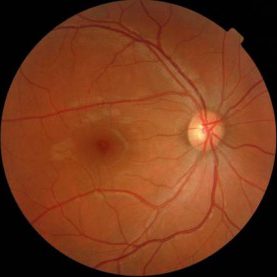DIABETIC RETINOPATHY
In industrialized countries, diabetes is one of the principal causes of predictable loss of vision among the adult population. The risk of blindness in the diabetic population is twenty-five times higher than in the general population. By keeping a strict check on a patient’s glycemia, it is possible to reduce by up to 80% the progression of diabetic retinopathy, a disease of the eyes produced by diabetes. Photocoagulation with laser on the affected retina can prevent more than 50% of blindness cases
What is diabetic retinopathy ?
It is a complication of diabetes which affects the eyes, caused by a deterioration of the blood vessels which nourish the retina. These weakened blood vessels may let liquid or blood out which flood the retina and the lack of blood irrigation to the retina induces the formation of new vessels which are very fragile and bleed easily.
Which people are most affected ?
The appearance of diabetic retinopathy is in relation to the time that the patient has suffered from diabetes. It is not related to the type of diabetes, which means that it can equally affect patients who are dependent on insulin and those who control their diabetes by means of pills or diet. Around 60% of patients who have had diabetes for 15 years or more have damaged blood vessels in their eyes, but only some of them have serious problems with their eyesight and develop blindness.
What are the symptoms ?
The symptoms of diabetic retinopathy are not always clearly perceived in time by patients. In some cases there is a gradual decrease in vision and in others difficulty in carrying out work which requires near vision. When hemorrhages occur, vision becomes blurred (with the patient perceiving spots) or they observe a sudden loss of vision.
What treatment is there ?
The best treatment is always early diagnosis and for this reason diabetics are recommended to have an annual ophthalmological check-up, with a study of the eye’s fundus to be able to analyze the changes which appear on their retina. In many cases no treatment will be necessary, but when it is, the most effective treatment consists in the use of a laser to close or photo coagulate the blood vessels which are presenting problems. Intravitreal injections can be a great help in order to facilitate the elimination of the diabetic’s anomalous blood vessels. However, success in the treatment of diabetic retinopathy does not only depend on early detection, vigilance and the treatment given by the ophthalmologist. It also depends on the attitude of the patient as to whether they follow the diet and treatments recommended to control their diabetes.

